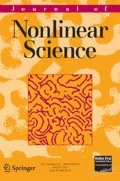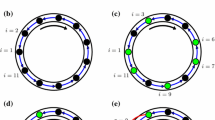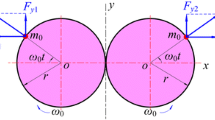Abstract
In this paper, we propose a novel technique to decompose networked systems with cyclic structure into nonlinear modes and apply these ideas to a system of connected vehicles. We perform linear and nonlinear transformations that exploit the network structure and lead to nonlinear modal equations that are decoupled. Each mode can be obtained by solving a small set of algebraic equations without deriving the coefficients for any other mode. By focusing on the mode that is loosing stability, bifurcation analysis can be carried out. The techniques developed are applied to evaluate the impact of connected cruise control on the nonlinear dynamics of a connected vehicle system.








Similar content being viewed by others
References
Cochelin, B., Damil, N., Potier-Ferry, M.: Asymptotic-numerical methods and Pade approximations for non-linear elastic structures. Int. J. Numer. Methods Eng. 37(7), 1187–1213 (1994)
Gasser, I., Sirito, G., Werner, B.: Bifurcation analysis of a class of ‘car following’ traffic models. Phys. D 197(3–4), 222–241 (2004)
Ge, J.I., Avedisov, S.S., Orosz, G.: Stability of connected vehicle platoons with delayed acceleration feedback. In: Proceedings of the ASME Dynamic Systems and Control Conference, pp. V002T30A006. ASME (2013). Paper no. DSCC2013-4040
Ge, J.I., Orosz, G.: Dynamics of connected vehicle systems with delayed acceleration feedback. Transp. Res. Part C. 46, 46–64 (2014)
Gendelman, O.V.: Bifurcations of nonlinear normal modes of linear oscillator with strongly nonlinear damped attachment. Nonlinear Dyn. 37(2), 115–128 (2004)
Georgiades, F., Peeters, M., Kerschen, G., Golinval, J.C., Ruzzene, M.: Modal analysis of a nonlinear periodic structure with cyclic symmetry. AIAA J. 47(4), 1014–1025 (2009)
Grolet, A., Thouverez, F.: Vibration analysis of a nonlinear system with cyclic symmetry. J. Eng. Gas Turbines Power 133(2), 022502 (2011)
Haterbouch, M., Benamar, R.: Geometrically nonlinear free vibrations of simply supported isotropic thin circular plates. J. Sound Vib. 280(3–5), 903–924 (2005)
Helbing, D., Moussaid, M.: Analytical calculation of critical pertubation amplitudes and critical densities by non-linear stability analysis of a simple traffic flow model. Eur. Phys. J. B 69(4), 571–581 (2009)
Jézéquel, L., Lamarque, C.H.: Analysis of non-linear dynamic systems by the normal form theory. J. Sound Vib. 149(3), 429–459 (1991)
Kerschen, G., Peeters, M., Golinval, J.C., Vakakis, A.F.: Nonlinear normal modes, Part I: a useful framework for the structural dynamicist. Mech. Syst. Signal Process. 23(1), 170–194 (2009)
Kuznetsov, Y.: Elements of Applied Bifurcation Theory. Springer, Berlin (2004)
Manevich, L.I., Mikhlin, Y.V.: On periodic solutions close to rectilinear normal vibration modes. J. Appl. Math. Mech. (PMM) 36(6), 1051–1058 (1972)
Nayfeh, A.H.: On direct methods for constructing nonlinear normal modes of continuous systems. J. Vib. Control 1(4), 389–430 (1995)
Nayfeh, A.H., Nayfeh, S.A.: On nonlinear modes of continuous systems. J. Vib. Acoustics 116(1), 129–136 (1994)
Olson, B.J., Shaw, S.W., Shi, C., Pierre, C., Parker, R.G.: Circulant matrices and their application to vibration analysis. Appl. Mech. Rev. 66(4), 040803 (2014)
Orosz, G.: Connected cruise control: modeling, delay effects, and nonlinear behavior. Vehicle Syst. Dyn. (submitted) (2014)
Orosz, G., Moehlis, J., Bullo, F.: Delayed car-following dynamics for human and robotic drivers. In: Proceedings of the ASME IDETC/CIE Conference, pp. 529–538. ASME (2011). Paper no. DETC2011-48829
Orosz, G., Stépán, G.: Subcritical Hopf bifurcations in a car-following model with reaction-time delay. Proc. R. Soc. 462(2073), 2643–2670 (2006)
Orosz, G., Wilson, R.E., Stépán, G.: Traffic jams: dynamics and control. Philos. Trans. R. Soc. A. 368(1928), 4455–4479 (2010)
Orosz, G., Wilson, R.E., Szalai, R., Stépán, G.: Exciting traffic jams: nonlinear phenomena behind traffic jam formation on highways. Phys. Rev. E. 80(4), 046205 (2009)
Peeters, M., Viguié, R., Sérandour, G., Kerschen, G., Golinval, J.C.: Nonlinear normal modes, Part II: toward a practical computation using numerical continuation techniques. Mech. Syst. Signal Process. 23(1), 195–216 (2009)
Qin, W.B., Gomez, M.M., Orosz, G.: Stability analysis of connected cruise control with stochastic delays. In: Proceedings of the American Control Conference, pp. 4624–4629. IEEE (2014)
Roose, D., Szalai, R.: Continuation and bifurcation analysis of delay differential equations. In: Krauskopf, B., Osinga, H.M., Galan-Vioque, J. (eds.) Numerical Continuation Methods for Dynamical Systems, Understanding Complex Systems, pp. 359–399. Springer, Berlin (2007)
Rosenberg, R.M.: On nonlinear vibrations of systems with many degrees of freedom. Adv. Appl. Mech. 9, 155–242 (1966)
Shaw, S.W., Pierre, C.: Normal modes for non-linear vibratory systems. J. Sound Vib. 164(1), 85–124 (1993)
Shladover, S.E.: Longitudinal control of automotive vehicles in close-formation platoons. J. Dyn. Syst. Meas. Contr. 113(2), 231–241 (1991)
Slater, J.C.: A numerical method for determining nonlinear normal modes. Nonlinear Dyn. 10(1), 19–30 (1996)
Szemplinska-Stupnicka, W.: “Non-linear normal modes” and the generalized Ritz method in the problems of vibrations of non-linear elastic continuous systems. Int. J. Non-linear Mech. 18(2), 149–165 (1983)
Wang, F., Bajaj, A.K.: Nonlinear normal modes in multi-mode models of an inertially coupled elastic structure. Nonlinear Dyn. 47(1–3), 25–47 (2007)
Zhang, L., Orosz, G.: Designing network motifs in connected vehicle systems: delay effects and stability. In: Proceedings of the ASME Dynamic Systems and Control Conference, pp. V003T42A006. ASME (2013). Paper no. DSCC2013-4081
Acknowledgments
This work was partially funded by the National Science Foundation (Award No. 1351456).
Author information
Authors and Affiliations
Corresponding author
Additional information
Communicated by Sue Ann Campbell.
Appendices
Appendix 1: Simplification of Cubic Terms
Before applying the cubic near-identity transformation (52), we need to express all the cubic terms of (50) using multiples of two circulant matrices. However, the cubic term \({\hat{\mathfrak {L}}}^{(\beta )}\Big ({\hat{\mathbf {S}}}_b\big (\hat{\varvec{\Psi }}({\hat{\mathbf {u}}}){\hat{\mathbf {u}}}\big )\Big )\,\hat{\mathbf {K}}^{(\beta )}_{b}\,{\hat{\mathbf {u}}}\) does not appear to have such structure. By spelling out the components corresponding to the dynamics of mode \(k\) (in other words the \(k+1\)-st row pair), we obtain
where \(m(\ell )\) is given as
If we consider a change of indexes \(\sigma =f_{k\ell }\), we get
Similarly, the \(k\)-th modal component of \({\hat{\mathfrak {L}}}^{(\beta )}\big ({\hat{\mathbf {S}}}_{b}({\hat{\mathbf {u}}})\big )\hat{\mathbf {K}}^{(\beta )}_{b}\hat{\mathrm {\varvec{\Psi }}}({\hat{\mathbf {u}}}){\hat{\mathbf {u}}}\) can be expanded as
If we re-label the \(\delta \) and \(\beta \), we obtain
Considering (105) and (107) for the same values of \(j,\,\beta ,\,\) and \(\delta \), and for \(\sigma =\ell \), we can show that
and hence (105) and (107) are equal. This means that (50) and (51) are identical.
Appendix 2: Cubic Near-Identity Coefficients (Left Hand Side)
The coefficient vector \({\tilde{\mathbf {b}}}_{k j\ell }\) in (57) is given by
where the constants \(\gamma _{kj}^{(\cdots )}\) and \(\phi _{ j\ell }^{(\cdots )}\) are defined in (53).
Appendix 3: Cubic Near-Identity Coefficients (Right Hand Side)
The coefficient vector \({\tilde{\mathbf {c}}}_{k j\ell }\) in (57) is given by

Appendix 4: Remaining Quadratic Terms for Mode 0
In Eq. (77), \(\frac{1}{2}{\hat{\mathbf {R}}}({\hat{\mathbf {u}}}){\hat{\mathbf {u}}}\) represents the quadratic terms that cannot be eliminated by the near-identity transformation (38) when modes 1 and \(N-1\) undergo a Hopf bifurcation. The only two nonzero entries in matrix \({\hat{\mathbf {R}}}({\hat{\mathbf {u}}})\) are given by
where subscripts denote the location of the block in \({\hat{\mathbf {R}}}({\hat{\mathbf {u}}})\), and \(q_{1}\) gives the value of \(q\) at the bifurcation point; cf. (10). Indeed, these quadratic terms correspond to the modes \(1\) and \(N-1\), and they only appear in the dynamics of the \(k=0\) mode. In the special case, when \(\beta =0\) and even \(N\) the term
also remains in the equation of the \(k=0\) mode due to mode \(N/2\).
Appendix 5: Quadratic Near-Identity Coefficients for the Connected Vehicle Example
Equations (83) and (88) contain four nonzero quadratic near-identity coefficients that can be obtained by solving (57) for the car following model:
where the factor \(\Delta \) is
and \(q_{1}\) gives the value of \(q\) at the bifurcation point; cf. (10). We remark that the coefficients \(\psi ^{(112)}_{21}\) and \(\psi ^{(121)}_{21}\) do not need to be evaluated individually since (83, 88) only include their sum.
Rights and permissions
About this article
Cite this article
Avedisov, S.S., Orosz, G. Nonlinear Network Modes in Cyclic Systems with Applications to Connected Vehicles. J Nonlinear Sci 25, 1015–1049 (2015). https://doi.org/10.1007/s00332-015-9249-6
Received:
Accepted:
Published:
Issue Date:
DOI: https://doi.org/10.1007/s00332-015-9249-6




